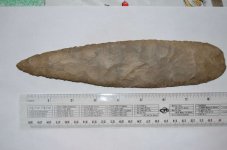Upnorth42
Full Member
I saw a spearhead today and took a photo of it and am wondering if anyone can make an informed guess as to its age. Any other information about it would also be appreciated.
The story is it was found many years ago (1800s) in a cranberry bog. Its 9" long and from where it was found I am guessing it was being used to hunt moose or caribou.
Its from Western Nova Scotia in Canada.
Thanks in advance for any replies
The story is it was found many years ago (1800s) in a cranberry bog. Its 9" long and from where it was found I am guessing it was being used to hunt moose or caribou.
Its from Western Nova Scotia in Canada.
Thanks in advance for any replies
Attachments
Upvote
0




